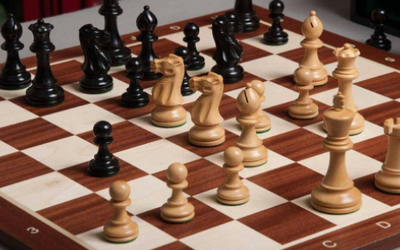
How to play a chess game
About chessLearn how the pieces move. Every type of piece moves differently. Here are the names of every piece and how they move (with a few exceptions, that will be covered in a bit):
- The pawn: The most basic piece in the game (you have 8 of them). On its initial move, it can move forward one or two vacant spaces, but it is only allowed to move forward one vacant space afterwards. Pawns cannot move forward if they are blocked by an enemy piece nor can they capture pieces directly ahead of them. Pawns capture pieces situated one space diagonally in front. The pawn is the only piece that cannot move backwards and is also the only piece that captures in a way that is different from how it normally moves. When a pawn reaches the eighth rank (for white) or first rank (for black) they are "promoted" into another piece (see below).
- The rook: Sometimes called a "castle" (though rook is more common to avoid confusion with the "castling" move, see below), the rook looks like a small tower. It can move horizontally or vertically as many spaces as are available. It can capture enemy pieces in its path.
- The knight: It's represented by a horse and is the most complicated of the pieces. It moves in an 'L' shapes that consist of two spaces horizontally then one space vertically, or one space horizontally then two spaces vertically. The knight is the only piece that can jump other pieces (of either color). However, the knight only captures an enemy piece if it is in the space where he settles.
- The bishop: It can only move diagonally, but can move an unlimited amount of spaces in that direction. It can capture enemy pieces in its path. Since it can only move diagonally, one of your bishops stays on the light-squares (and is called the "light-squared bishop") while the other stays on the dark-squares (and is called the "dark-squared bishop").
- The queen: She is the most powerful piece and can usually be identified by her feminine crown). She can move either horizontally, vertically, or diagonally by any number of spaces and capture from any of those directions.
- The king: He can only move one space each turn in any direction and captures in the same manner. He is the unit you do not want to lose at all cost but is never actually captured. It is an illegal move for a player to move his own king into check (a check is when the king could be captured on the next move but still has an option of escape). A check that occurs as a result of an opponent's move must be resolved immediately, and checkmate (when your king has no place to move safely) loses the game.
- Remember the strong points of the pieces.
- The king is valuable and must be protected.
- The queen is the most versatile piece and is the most useful for supporting pieces, and often used for forking. The queen combines the power of a bishop and a rook in one piece. She is considered to be the most valuable, next to the King.
- Knights are excellent for surprise attacks and forks. Their pattern of movement is often missed and confusing to novice players.
-
- Bishops tend to be an excellent in an open position. However many novice players often underestimate bishops and do not make full use of them.
- Rooks are strong and have a long range of movement. They work best on open files.
- Pawns may seem insignificant, but they can be great for trapping an opponent when sacrificed to capture a more valuable piece. Pawns can also be promoted (see below) if they reach the eighth (or first) rank. If played right, a pawn can even checkmate the King!
- Understand what is meant by "check". If your king is in check, he is under attack from one of your opponent's pieces. When your king is in check, you MUST move out of check on your very next turn. You can get out of check by one of three methods:
- By moving your King to a safe square. A safe square is one, where your king will not be in check.
- By capturing the checking piece.
- By blocking with one of your pieces. This does not work for Pawns and Knights.
- If it is impossible to remove your king from check on the next move, this is called checkmate. The game is over and you have lost
- Understand how to win. In chess, you are trying to checkmate your opponent's king. Checkmate is when a king is trapped and has no safe spaces. However, you can also win by resignation or timeout.
- Checkmate is basically check but with no way to remedy the check.
- When a player resigns it means that they've given up. The game is over and the resigner's opponent is victorious.
- Timing out is when a player runs out of time on the clock. Casual players often don't play with a clock but if you do you can lose by running out of time.
- Chess is a game of intelligence and strategy. There are many moves and rules that beginners will not be able to foresee or understand initially. Be patient! It gets more and more fun the more and more you play. You won't become World Champion overnight!


